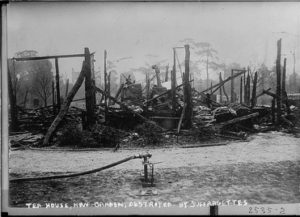The public perception of the suffragette movement, some 100 years ago, tends to see it as somewhat non-violent, all “handcuffing to the railings” and ladies throwing themselves in front of horses. But a deeper dive into history shows that the suffragettes made use of IEDs between 1912 and 1914. Perhaps my wife who regards my blog with disdain as being “boring and irrelevant” : -) will appreciate these stories.
A small number of the IEDs contained dynamite rather than gunpowder. Here’s a selection of a the few dozen or so that I have found records of:
- In 1913 suffragettes planted a 5lb gunpowder IED in a house at Walton Heath in Surrey belonging to politician Lloyd George, severely damaging it, and the components of a second IED were discovered in the house. The device was believed to have been very crude and initiated by a candle burning down to a metal can of gunpowder, surrounded by nails. A similar device was used at a house not far away Walton-on-the-Hill three weeks later.
- Also in 1913 a dynamite IED was planted in St Paul’s Cathedral, but it failed to detonate. An EOD team from the Chief Inspector of Explosives led by Major Cooper-Key of the Royal Engineers dealt with the device (after it had been placed in a bucket of water (!!). It contained ¾ of a pound of nitroglycerine, in a metal case. A small adapted watch and a battery were connected to an electric detonator. However the electrical connection was faulty and the device failed.
- On April 14, 1913, a small timed device was found attached to railings outside the Bank of England.
- In January 1914 two IEDs with burning fuzes were planted in the Kibble winter botanical gardens in Glasgow. A night-watchman, came across one device with the fuze burning. He bravely cut the fuze off with a pocketknife. Seconds later a second device exploded causing considerable damage.
- On 11 June 1914, an IED hidden in a lady’s handbag was placed on the back of “King Edwards chair” or the coronation throne in Westminster Abbey , the throne built around the historical “Stone of Scone”. The device exploded causing minor damage and reportedly contained steel nuts as shrapnel.
The suffragettes also used letter bombs (and acid devices) posted to intended victims, as well as a significant series of straightforward arson attacks.

Update there’s a later post containing a more comprehensive list of suffragette explosive devices.

Fascinating. Have you come across any similar devices tied with the suffragette movement in the US during the same time period? The US had a number of anarchist and labor related IED attacks during the time, but no news that suggested a suffragette motive. It would be interesting to see if there was, and that would technically make the suffragette movement an international terrorist group under today's guidelines.
And the mention of EOD. Was it listed as EOD then or RE in an EOD function? The reason I am curious is that our history here has the EOD field being born (borne) out of the Blitz and UXO units, then we improved (stole) the concepts when we integrated them into our military. But as you have mentioned before, areas like New York had a long standing bomb squad service before WWII on the civilian side. Just curious.
Finally, aside from the purse as a delivery method, I didn't see any link to the suffragette movement. Was there a corresponding threat or press campaign by the suffragettes against the targets listed above?
Keep up the great history work.
Al. Glad you enjoyed the post. I have quite a bit on US anarchist attacks including the infamous Haymarket bombing in Chicago. But I don't have much on US suffragettes – I'll look. The attacks were a part of a broader range of attacks on churches and art galleries pushing the cause.
As far as "EOD" history is concerned, it's quite complicated. The EOD done around this time in civil situations was done by a "Home Office" department called the Office of the Chief Inspector of Explosives who also were involved in industrial explosives policy management. In broad terms it was manned by officers seconded from the Army. The first one was the famous Colonel Majendie of the Royal Artillery, the second Capt Thompson who tragically committed suicide. Cooper-Key (above) was about the third or fourth and he happened to be a Royal Engineer with an interest in explosives, which I think was the primary qualification. Cooper-Key was interesting because his father, a Royal navy Admiral also had a great interest in explosives which I guess he inherited. So the Royal Engineer bit was coincidental. The bun fight between Engineers and Ordnance EOD didn't start till later and I guess is still being kicked around.